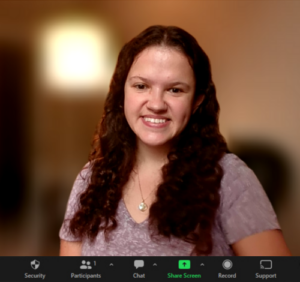
Emily Hipp, MS CCC-SLP
It’s a pleasure to introduce our March Teletherapist Spotlight, Emily Hipp.
1. How do you incorporate creativity and interactive activities into your speech-language teletherapy sessions, ensuring that they are engaging and enjoyable for your students?
My students love playing different themed games and reading different books. If a student is not as engaged as I thought they would be with a specific activity, I try to change the activity to get more engagement. Students also feel empowered when given choices. Suppose a student isn’t having their best day or isn’t participating in the activity presented. In that case, I like to give them activity choices to see what might help their engagement and participation. For students who are very young and/or unable to engage in on-screen activities, my E-Helper helps to model language and facilitate play-based therapy sessions.
2. In your experience, how does teletherapy address the specific needs of clients with diverse communication disorders, and what customized approaches have you found effective in tailoring sessions to individual requirements?
With so many different online resources, I am able to adjust activities to meet a child’s needs easily. I typically change the level of the activity and/or the questions and targets that are worked on through a specific activity to meet the child where they are. If a child needs more support, I can provide visuals and more prompting throughout the activity. If the child is more independent, I can take away some of the support and allow them to complete the activity more on their own.
3. As a teletherapist, what advice can you offer to parents and caregivers for creating a conducive and supportive environment to enhance their child’s speech and language development between therapy sessions?
The best way to create a supportive environment and enhance a child’s speech and language at home is to engage with your child. Whether that be through toys, books, crafts, or bike riding. Engaging with your child allows for a language-rich environment and appropriate modeling of speech/language skills throughout the home. Hearing appropriate speech/language skills throughout their daily life is important to a child’s speech and language development.
4. How has teletherapy transformed the landscape of speech-language pathology, and what unique advantages does it offer for both therapists and clients?
With teletherapy, we are able to serve groups of students who would not otherwise be able to receive therapy at their school without teletherapy. For therapists, teletherapy offers a more flexible setting. While we are working with children and completing documentation all day long like any in-person therapist would be, teletherapy allows us to be remote and enjoy a more relaxed home environment, while also continuing to work in the therapy setting. Before teletherapy became popular, it would have been almost impossible to have a SLP job without leaving your home.
5. Could you share success stories or examples of breakthrough moments you’ve witnessed while providing speech-language teletherapy, highlighting the impact it can have on clients’ lives?
Therapy impacts each student’s life, even if it may seem like such a small part of their life to us. Students have so much going on in their lives and just 30 minutes a week of small group or 1:1 means so much to them. It is so rewarding to see students meet their goals and even just look forward to coming to therapy each week.
6. With the increasing demand for teletherapy services, what technological tools and platforms do you find most valuable in delivering high-quality speech-language therapy online?
There are a variety of tools and platforms that I like to use in my therapy sessions. My “go-to” platforms are SuperDuper Digital Library, Ultimate SLP, Baamboozle, Pink Cat Games, and YouTube.
7. As a teletherapist, how do you address challenges related to building rapport and maintaining a connection with clients in a virtual setting?
Establishing rapport with my students was not as challenging as I thought it would be. Students today are so used to communicating with adults and peers in a virtual setting as most of them experienced online school during COVID-19 and many of them have family members that they FaceTime with as well.
8. What tips do you have for other speech-language therapists looking to transition to teletherapy successfully, and what common misconceptions about teletherapy would you like to dispel?
I recommend researching and asking questions about the various teletherapy companies. I was so lucky to know someone who worked at Unlimited Teletherapy already, so I was able to reach out to her to learn more about it. Some people may think that teletherapy is boring or that it is hard to engage and build rapport with students and teachers –
this isn’t true at all! I would say that teletherapy is very similar to in-person therapy and you never know if you’d like it until you give it a try!
Emily is one of many of our Teletherapists at Unlimited Teletherapy that is passionate, nurturing, and committed to supporting students to meet their individual goals. We are honored to have her on our team!



Comments are Closed